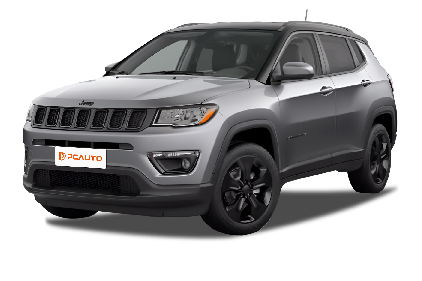Q
What is the maximum range of the Jeep Compass?
The Jeep Compass 2.4 Limited (2014) has a fuel tank capacity of 51 liters. However, its maximum range depends on various factors such as driving habits, road conditions, and vehicle load. With a 51-liter fuel tank, under ideal conditions with efficient driving, it can achieve a long range, but the actual range often varies. For example, if the vehicle averages around 10 liters per 100 kilometers (this is just an estimate as actual consumption may differ), it could travel approximately 510 kilometers on a full tank. Regular maintenance like proper tire inflation, timely oil changes, and efficient engine tuning can also improve fuel efficiency and increase the maximum range. Keep in mind these are approximations and the actual maximum range may fluctuate.
Special Disclaimer: This content is published by users and does not represent the views or position of PCauto.
Related Q&A
Q
Is the Jeep Compass engine powerful?
The Jeep Compass 2.4 Limited (2014) is equipped with a 2.4L naturally aspirated inline-four engine that delivers 172 horsepower at 6000 rpm and a peak torque of 224 Nm at 4400 rpm. Whether an engine is powerful enough depends on individual needs and expectations. For urban commuting and light off-road driving, this engine provides adequate power for smooth acceleration and overtaking. It is paired with an automatic transmission and an all-wheel drive system, ensuring stable performance across various road conditions. However, if you seek high-performance driving with rapid acceleration and high top speeds, this engine may not meet those expectations. Overall, it strikes a good balance between daily usability and light adventure capabilities.
Q
How much does it cost to fill up Jeep Compass?
The Jeep Compass has a fuel tank capacity of 51 liters. However, the actual cost to fill it up depends on current fuel prices. Gasoline prices fluctuate - taking standard RON 95 as an example, if its price is RM 2.20 per liter, a full tank would cost approximately RM 112.20. For RON 97 priced at RM 2.50 per liter, filling the tank would require RM 127.50.
Fuel consumption varies significantly based on driving habits and road conditions. Proper driving habits and favorable road conditions can improve fuel efficiency, reducing refueling frequency and costs. Conversely, aggressive driving and challenging terrain increase fuel consumption, leading to higher refueling expenses.
Q
Does Jeep Compass have a spacious room?
The room of Jeep Compass is spacious. With a length of 4404mm, width of 1760mm, height of 1656mm and wheelbase of 2634mm, it provides an ample space inside. The five-seat layout means there's enough room for a small family. The front seats offer manual adjustability for the driver and passenger, and the passenger seat has features like tumble-fold and heating. The rear seats can be split 60:40, which not only gives flexibility for seating arrangements but also allows for more cargo space when needed. The trunk has a volume of 458L, which is sufficient for daily groceries or a couple of suitcases for a short trip. Also, features like a single sunroof increases the sense of spaciousness and airiness inside the vehicle, making the Jeep Compass a good choice for those seeking a vehicle with adequate space.
Q
Is the Jeep Compass SUV or XUV?
The Jeep Compass is a compact SUV that has the typical features of an SUV. It has elevated ground clearance that enables it to easily handle challenging terrains with better passability than conventional sedans. Its interior offers adequate space, providing ample room for both passengers and cargo to meet the consumers' needs for daily commutes and family travel.
In design, it carries forward Jeep's iconic DNA with the classic seven-slot grille paired with distinctive headlights, complemented by muscular body lines. For the hood, it offers a range of powertrain options including gasoline engines, as well as electrified variants like mild-hybrid, plug-in hybrid, and all-electric versions to cater to consumers'diverse preferences.
Some models are equipped with an intelligent 4WD system, delivering off-road performance—all of which align with authentic SUV traits rather than the XUV.
Q
What type of vehicle is the Jeep Compass?
The Jeep Compass is a compact SUV that belongs to the Jeep family. With a body length of 4,404mm, width of 1,760mm, height of 1,656mm, and a wheelbase of 2,634mm, its dimensions secure its position in the compact SUV segment. For the hood, it once offered a 2.4L naturally aspirated engine version producing 172PS maximum horsepower, sufficient for daily driving needs.
In terms of features, the vehicle is equipped with numerous practical and comfort-oriented configurations. In safety, it includes six standard airbags, electronic stability control, hill start assist, etc. The front seats offer manual adjustment, supporting heating functionality, while the rear seats feature a 60:40 split-folding capability for flexible cargo space expansion. Additionally, the multifunction steering wheel and 6.5-inch touchscreen infotainment system further enhance the driving experience.
With these characteristics, the Jeep Compass is suitable for both daily commutes and outdoor adventures, which is a good choice for consumers.
Q
How far can an empty-fuel Jeep Compass travel?
It's difficult to determine exactly how far an empty-fuel Jeep Compass can travel, as this depends on various factors like driving style, road conditions, and vehicle load. The 2014 Jeep Compass 2.4 Limited has a 51-liter fuel tank, with actual fuel consumption varying between drivers - typically ranging from 11 to 15 liters per 100 kilometers.
Assuming approximately 10 liters of fuel remain when the warning light activates (this is a rough estimate and varies by vehicle), at a consumption rate of 12 liters per 100 km, the theoretical remaining range would be around 80 kilometers. However, this is only an estimate. In practice, to avoid potential fuel pump overheating damage because of insufficient cooling, which may even cause the breakdown of vehicle, it's strongly recommended to refuel the vehicle as soon as possible after the warning light illuminates.
Q
Which country does Jeep Compass come from?
The Jeep Compass is an American brand. Jeep is an automotive brand with a profound historical heritage and is affiliated with Chrysler Corporation in the United States. This brand is renowned worldwide for producing off-road vehicles with outstanding performance. As a member of the Jeep family, the Jeep Compass inherits the brand's unique features. It combines classic design with modern technology, featuring iconic exterior elements of the Jeep brand such as the seven-slot grille and a series of advanced configurations, such as the available Freedom Drive active full-time 4WD system, which enhances its on-road stability and off-road capability. In Malaysia, many consumers favor the Jeep Compass, as it offers unique and distinctive options for local SUV buyers.
Q
What is the fuel capacity of Jeep Compass?
The fuel capacity of the Jeep Compass is 51 liters, which helps improve the driving range. The fuel tank capacity refers to the volume from the bottom of the fuel tank to the safe fill level. In actual refueling, it may exceed the calibrated value because there is still space from the safe fill level to the fuel tank opening, which is to prevent fuel overflow due to thermal expansion. This vehicle runs on gasoline, and its fuel consumption per 100 kilometers fluctuates within a certain range. Understanding the fuel capacity is important for trip planning. For example, before a long-distance trip, check the remaining fuel level and plan refueling stops in advance. During daily use, it is also recommended to monitor the remaining fuel level through the vehicle's fuel gauge and refuel the vehicle promptly when the level is low to avoid travel disruption due to fuel depletion.
Q
Is Jeep Compass the full-size car?
Jeep Compass is not the full size car. It is a compact SUV, categorized into the C-Segment. With a length of 4404mm (for the 2014 model) and a wheelbase of 2634mm, its dimensions make it a compact vehicle. Full size cars or SUVs typically have larger dimensions, offering more spacious interior, especially in terms of passenger room and cargo capacity. However, over the years, the Compass has undergone upgrades. The newer versions have increased in size, with a length reaching 4550mm and an extended wheelbase of 2795mm, which also boosts the cargo space to 550L. This evolution makes it more spacious than before, yet still within the category of compact vehicle.
Q
How many miles can Jeep Compass travel on a full tank?
The fuel tank capacity of the Jeep Compass 2.4 Limited (2014) is 51L, and the actual average fuel consumption is 10.6L per 100km. Through calculation, the vehicle can travel approximately 481.13km on a full tank. Since 1 mile is approximately equal to 1.60934 kilometers, after conversion, it can travel approximately 299 miles. However, this is just a theoretical estimate, and the actual range will be affected by various factors such as driving habits, road conditions, and vehicle load. For example, aggressive driving habits like rapid acceleration, hard braking, and frequent lane changes, as well as driving in congested traffic or on rough terrain, will increase fuel consumption and reduce the range; whereas smooth driving, maintaining proper tire pressure, and regular vehicle maintenance will help improve fuel efficiency and extend the range.
Popular Cars
Model Year
Car Compare
Car Photo
Latest Q&A
Q
How much did a new 2018 beetle cost?
The 2018 Volkswagen Beetle had a starting price range of approximately RM120,000 to RM180,000, depending on the trim and options. The entry-level 1.2 TSI Design model was the most affordable, while the top-spec 2.0 TSI R-Line version approached RM180,000—though final pricing could vary with optional extras and dealer promotions.
As a timeless classic, the 2018 Beetle kept its retro charm but packed modern tech like a touchscreen infotainment system and active safety features. Under the hood, buyers could choose between the fuel-efficient 1.2T or the more spirited 2.0T engine.
Fair warning: Volkswagen discontinued the Beetle in 2019, so you’ll only find it on the used market now. That said, its iconic design and nostalgic appeal still make it a hit among collectors. If you’re eyeing a pre-owned model, always check the vehicle history and maintenance records to snag a solid deal.
Q
What engine does a 2018 VW Beetle have?
The 2018 Volkswagen Beetle offered two gasoline engine options across different markets. The primary powerplant was a 1.2-liter TSI turbocharged inline-four, delivering 105 horsepower and 175 Nm of torque, paired with a 7-speed DSG dual-clutch transmission. This compact forced-induction engine struck a balance between urban fuel efficiency and strong low-end torque.
Higher-spec variants featured an optional 1.4-liter TSI turbocharged unit, bumping output to 150 horsepower. Both engines adopted direct fuel injection and belonged to VW’s widely used EA211 modular family, featuring modern tech like lightweight aluminum blocks.
Though retaining its iconic silhouette, this generation Beetle actually shared its underpinnings with the Golf, inheriting the brand’s proven front-wheel-drive architecture. This platform commonality also translated to easier maintenance, as local dealerships were well-versed in servicing these powertrains thanks to extensive parts sharing across VW’s lineup.
Q
What are the different models of the 2018 VW Beetle?
The 2018 Volkswagen Beetle comes in three main trims: Classic, Trendline, and Sport. All models are powered by a 1.2-liter TSI turbocharged engine delivering 105 horsepower, paired with a 7-speed DSG dual-clutch transmission—perfect for city driving with its nimble handling and solid fuel efficiency.
The entry-level Classic trim rolls on 16-inch wheels and features a basic multimedia system. Stepping up to the Trendline adds 17-inch wheels, fog lights, and chrome accents. The Sport trim leans into its name with 18-inch wheels, a sport-tuned suspension, and unique interior color options.
This generation keeps the Beetle’s iconic retro curves but modernizes them with touches like LED daytime running lights. Inside, you’ll find color-matched dash panels, and with 310 liters of trunk space, it’s more practical than most small cars in its class.
Since the Beetline was discontinued in 2019, the 2018 model stands as the last new generation, making it a rising collector’s item—especially the convertible, which holds strong appeal in the used market. For maintenance, stick to routine service every 15,000 km or 12 months, and regular 95-octane fuel is all it needs.
Q
Does the 2018 Beetle have Apple CarPlay?
The 2018 Volkswagen Beetle did come equipped with Apple CarPlay, integrated into its Composition Media infotainment system. This allowed iPhone users to seamlessly connect for navigation, music, and other apps. The system also supported Android Auto, catering to different smartphone users with its intuitive and responsive interface—definitely a plus for convenience on the road.
That said, some early-production 2018 models might require a software update to activate the feature, so it’s worth checking with an official dealer to confirm your car’s specs or available upgrades. Also, wireless Apple CarPlay wasn’t standard across all trims; it depended on the factory-installed options.
For fans of classic styling who still want modern tech, the Beetle struck a nice balance between retro charm and everyday usability. Competitors like the Mini Cooper offered similar connectivity, but let’s be honest—the Beetle’s iconic design was always its standout feature.
Q
What is the fuel economy of the 2018 Beetle?
The 2018 Volkswagen Beetle's fuel efficiency varies by powertrain. The 1.2L TSI turbocharged version delivers a combined fuel consumption of around 5.5L/100km, while the 1.4L TSI model is slightly thirstier at approximately 6.0L/100km – both perform best with 95-octane petrol.
You'll likely see higher consumption in city driving, but it cruises efficiently on highways thanks to its classic aerodynamic design. For better mileage, stick to routine maintenance like cleaning the air filter and keeping tyres properly inflated. These small habits can help squeeze out extra kilometres per litre.
Though discontinued, the 2018 Beetle remains popular in the used car market – its iconic styling and decent fuel economy make it a practical daily driver. Just remember real-world figures depend heavily on driving style and road conditions, so check owner forums for real-life feedback.
View More



















Pros
Cons